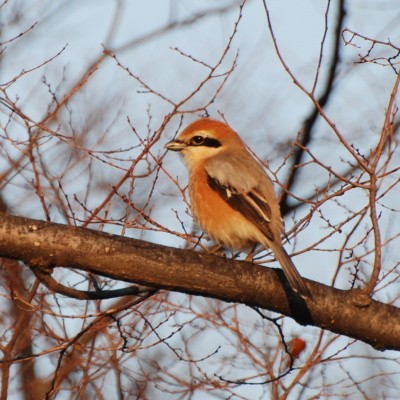Bull-headed Shrike
A species of Typical shrikes Scientific name : Lanius bucephalus Genus : Typical shrikes
Bull-headed Shrike, A species of Typical shrikes
Botanical name: Lanius bucephalus
Genus: Typical shrikes
Content
Description General Info
 Photo By Kuribo , used under CC-BY-SA-3.0 /Cropped and compressed from original
Photo By Kuribo , used under CC-BY-SA-3.0 /Cropped and compressed from original Description
The bull-headed shrike (Lanius bucephalus) is a passerine bird of eastern Asia belonging to the shrike family Laniidae. It is 19–20 cm (approx. 7.48-7.9 inches) long. The male has a brown crown, white eyebrow and black mask. The back is grey-brown while the wings are dark with a white patch. The flanks are rufous and the rest of the underparts are whitish with fine barring. Females are similar but duller and browner with a brown mask and no white wing-patch. The species has harsh grating and chattering calls and will also mimic other birds. It breeds in north-east China, Korea, Japan and far-eastern Russia (Ussuriland, Sakhalin and the Kuril Islands). Northern birds migrate south for the winter with a few reaching southern China. Vagrants have been recorded in Taiwan, Hong Kong and Vietnam. The isolated race sicarius is found only in the mountains of Gansu Province in west-central China. Open habitats such as farmland and woodland edges are preferred. It also visits parks and gardens in urban areas. It sits on a prominent perch, waiting for prey to pass by. It feeds mainly on insects such as beetles and crickets but also preys on lizards and crustaceans. With some other species from the Lanius genus, like the great grey shrike (Lanius excubitor), the bull-headed shrike is known to impale some of its preys upon a sharp point – usually thorns – so the food can be ripped into bite-sized pieces more easily. It may also do this to cache food and to mark a territory boundary. The nest is built among bushes or bamboo. Two to six eggs are laid. They are incubated for 14 to 15 days and the young birds fledge 14 days after hatching. 
Size
20 cm
Colors
Brown
Black
Yellow
Gray
White
Life Expectancy
8 years
Nest Placement
Shrub
Feeding Habits
Bull-headed Shrike primarily consumes insects like beetles and crickets, along with lizards and occasionally crustaceans. Bull-headed Shrike's varied diet reflects its opportunistic foraging and adept hunting skills.
Habitat
The bull-headed Shrike is commonly found in a variety of open habitats including farmlands, woodland edges, and suburban areas with parks and gardens. It can also be found in regions with scattered shrubs, hedgerows, shelter-belts, and forest edges. In the colder months, some individuals may migrate to woodlands which may be snow-covered, indicating a degree of adaptability to different seasonal environments. The bull-headed Shrike's habitat range spans from sea level to highlands, with breeding occurring up to altitudes of 1500-1800 meters and its presence recorded up to 2700 meters.
Dite type
Carnivorous
General Info
Feeding Habits
Bird food type
Species Status
Not globally threatened.
Scientific Classification
Phylum
Chordates Class
Birds Order
Perching birds Family
True shrikes Genus
Typical shrikes Species
Bull-headed Shrike